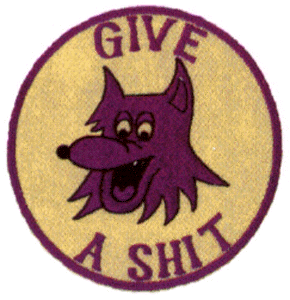

PRELUDEWhile attempting to establish a definitive date for the birth of "The Purple Foxes" your Webmaster has discovered that our logo evolved over several years and on the soil of at least three or four countries to include Mexico, the United States, the Philippine Islands, the Republic of South Vietnam and now Iraq. Further, it has been determined that there were a few times when the logo's continued existence was in a precarious status. The following submissions are presented in chronological order as recalled by the Marines of HMM-364.
This is the origin of the Purple Foxes as told by one of the culprits who started the whole thing. As all good sea stories go it begins with “This is no shit.” The earlier stories posted on The Purple Fox web site web site are fairly accurate but the real blame for the start of the Purple Foxes falls upon a group of five Lieutenants, Ron Elmone, Dick McMann, Duke Molner, Brice Luedtke, and Wally Krywko. If anyone person could be said to the Purple Fox it would be Ron as he was the biggest clown of the bunch but in reality it was a group effort with three ring leaders, Brice tagging along and Wally in the rear.
Following the assignation of President Kennedy in 1963 General Green and the other members of the Joint Chiefs of Staff began realigning their respective forces in anticipation of the up coming “JOHNSON INTERNATIONAL WAR GAMES.” As a result the Marine Helicopter pipeline was enlarged and aimed full force at the West Coast flooding MCAF Santa Ana with newly designated Naval Aviators. Understandably there was no way the existing structure could possibly handle all the eager fresh young pilots. Faced with an unlimited amount of free time and absolutely no responsibility whatsoever this large group of newbies did what Lieutenants the world over do, go to the beach, the bar, chase girls and generally get into trouble. After some months MAG -36 attempted to form into an effective unit and began realigning asset and responsibilities designating HMM-364 as the training unit upon it’s return from Viet Nam. A group of experienced pilots were assigned to the squadron to get it off the ground and become the instructors. They were all fighter pilots who had just transitioned into helicopters after flying the retired F-8U Crusader and were absolutely delighted to be chosen for this plumb assignment. A member of this select group was Captain Jim Coleman a Texas cowboy through and through who played the role to the hilt and in fact was actually the real deal, quite colorful very vocal and not at all politically correct or restrained in the slightest. He initially was the S-1 responsible for the welfare of the new pilots getting the administration right. If you had a problem you were to see him. The results of a meeting this compassionate gentleman usually went along the lines of “What makes you think I give a shit about you or your piss ant problems! Get your ass out of my fucking office!” delivered at a substantial volume level which immediately drew the attention of the above mentioned group. Getting Captain Coleman’s goat instantly became a fun project. Suddenly the good Captain was faced with a multitude of problems as a steady stream of Lieutenants seeking advice poured into his office resulting in a tirade wherein the phrase “… give a shit” could always be found.
The Purple Fox made its appearance as a crayon drawing attached to a note to Capt. Coleman with a thumb nail photo of the good Capt. clearly visible in the butt hole of the the Purple Fox. Needless to say an unbelievable explosion occurred in the office spaces that day and many following days as we had an unlimited supply of the photos on hand. The drawings quickly evolved into the small stuffed animal which continued to be a presence in the squadron spaces and was put to assorted fun uses.
The merriment continued until orders to prepare to mount out were received and life suddenly became very serious as the Squadron began preparations for deploying to Vietnam. It was immediately obvious that we were going to be short on every thing from parts, to trained crews to support equipment to the basic essentials. The only thing not lacking was the motivation to get the job done. We didn’t give a shit about the rest of the crap. Maintenance saw to the painting of our new motto and the image of our mascot on the tail of each aircraft as we pilled what we had been able to beg borrow or steal on board the USS Princeton. With the rest of MAG-36 we sailed off to Vietnam with 36 lieutenants and all their gear crammed into a 20 x 35 foot bunk room.
After what seemed like forever we off loaded at Ky-Ha and moved 18 each into comfy 12 man GP tents with no flooring and no electricity. At first the base location was just red clay with the dust getting into everything. Then the monsoon started and the clay became mud that stuck and was impossible to remove. We continued operating soaked to skin without a dry sock to be found and only C-rations to eat. After a few weeks the first hot meals consisting of soup (?), warm bread and coffee were provided. In spite of poor living conditions and the lack of parts and heavy maintenance support the squadron pressed on performing in an exceptional manner which did not go unnoticed. The pace we set resulted in the Captain of the USS Princeton requesting our HMM-364 be returned to his ship as the Squadron that replaced us in the rotation could not duplicate our performance. If a unit requested help who gave a shit how hot the LZ was our brothers in arms needed assistance and we were there. There are countless examples of Purple Fox crews conducting precarious missions such as Tim Woosley slinging in a resupply to a surrounded Marine mountain top outpost running out of ammo and receiving heavy fire or Dick Gleason and crew flying for 14 plus straight hours resupplying an Army Special Forces camp in trouble at Hep Duc. The Squadron participated in every major operation and could be counted upon to accept any assignment regardless of the challenges of weather , terrain, distance, time or the enemy situation. Everyone flew until the day before the date they were to go home. This can do attitude became part of each Squadron members psychological make up and stayed with him as he moved on in life. Over the years it has served us well, for the goal is always: just a little bit further, just a few more steps.
Wally Krywko
MARCAD, USMC, RETIRED
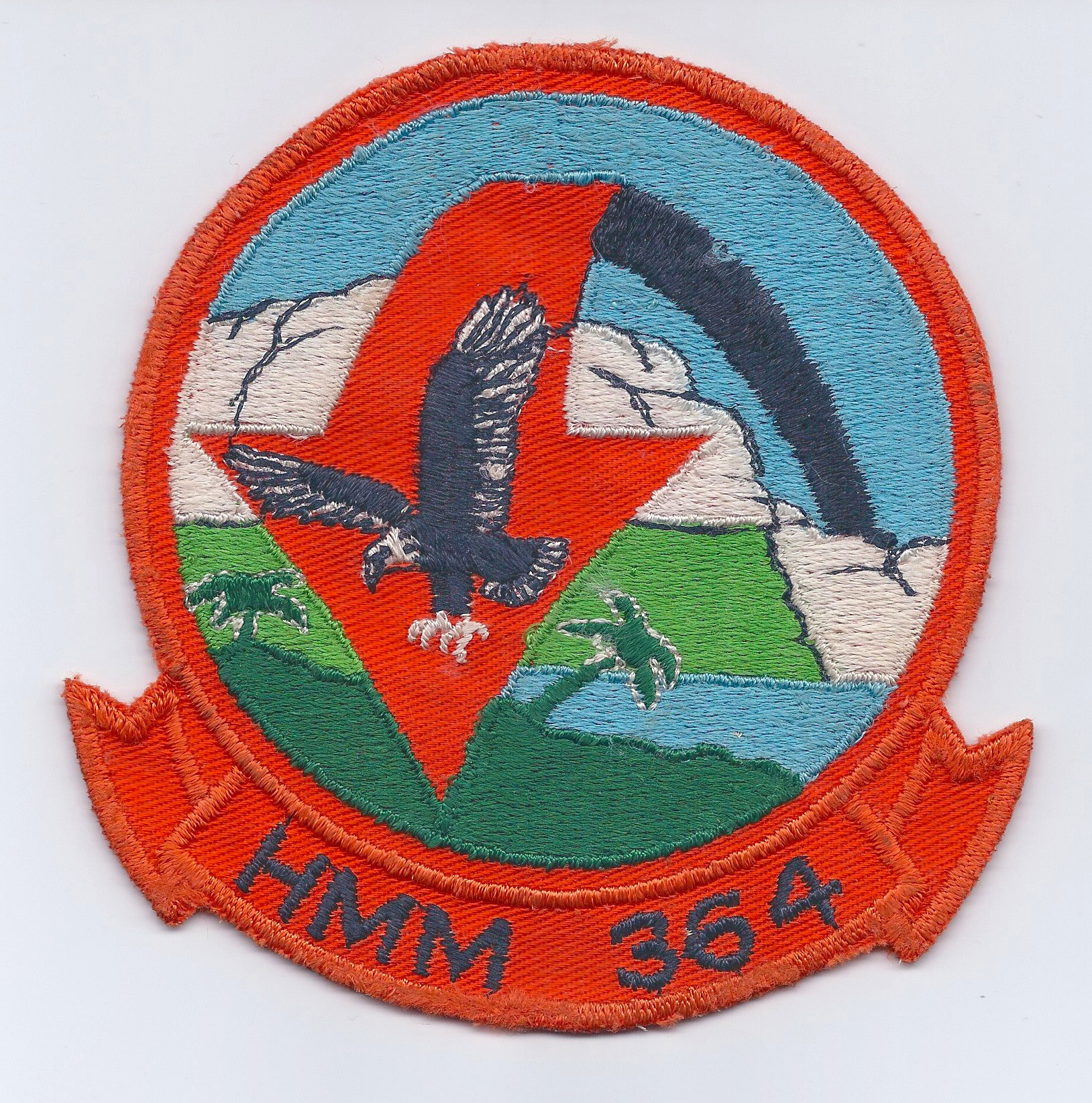
 Our
squadron patch remained the same but, I recall when some of us adopted
the name of "Purple Foxes" for the squadron. In late 1963, when we
were gearing up to go to WestPac and on to Vietnam from Okinawa, a number
of the pilots and troops were going to Tiajuana, Mexico and they found
a watering hole there named the Purple Fox. We were quite taken with
the place and wanted to take something of it with us, so we adopted the
name. It was not until the mid 60's though that it became legendary.
We were not looking to build legends but rather to survive and get everyone
home in one piece. I was fortunate, or unfortunate, to have had two
tours in Vietnam in the same squadron. After the '64 tour, the personnel
of the squadron were broken up and sent to their respective new duty stations
back in the States or home. Many of the crew chiefs and mechanics
were assigned to sunny southern California and we decided while on leave
that when we checked in for duty, we would try to get back into HMM-364
which was reforming at MCAF Santa Ana. That worked out great and
we had a squadron full of highly experienced Marines who having had one
tour in Vietnam would probably watch the war from the sidelines.
However, that was not to be and we wound up at Ky Ha, South Vietnam in
the third quarter of '65. It was then that the embryonic Purple Fox
began to grow. It was during this time frame that the legend was
built. We didn't really do much that anyone else in Marine helicopters
didn't do, but we did it with a lot of style and class.
Our
squadron patch remained the same but, I recall when some of us adopted
the name of "Purple Foxes" for the squadron. In late 1963, when we
were gearing up to go to WestPac and on to Vietnam from Okinawa, a number
of the pilots and troops were going to Tiajuana, Mexico and they found
a watering hole there named the Purple Fox. We were quite taken with
the place and wanted to take something of it with us, so we adopted the
name. It was not until the mid 60's though that it became legendary.
We were not looking to build legends but rather to survive and get everyone
home in one piece. I was fortunate, or unfortunate, to have had two
tours in Vietnam in the same squadron. After the '64 tour, the personnel
of the squadron were broken up and sent to their respective new duty stations
back in the States or home. Many of the crew chiefs and mechanics
were assigned to sunny southern California and we decided while on leave
that when we checked in for duty, we would try to get back into HMM-364
which was reforming at MCAF Santa Ana. That worked out great and
we had a squadron full of highly experienced Marines who having had one
tour in Vietnam would probably watch the war from the sidelines.
However, that was not to be and we wound up at Ky Ha, South Vietnam in
the third quarter of '65. It was then that the embryonic Purple Fox
began to grow. It was during this time frame that the legend was
built. We didn't really do much that anyone else in Marine helicopters
didn't do, but we did it with a lot of style and class.
George H. Dodds, former Sgt. USMC
 During the period 7 December 1964 through June 1965 while I was the Commanding
Officer, squadron pilots all too frequently would ask me to approve surveys
for expensive flight gear that had been lost because it had not been properly
secured. To say the least, I wasn't too happy with the frequency
of such requests. So, some unnamed "wag" in the squadron located
a fake fur pelt that had eyes, ears and a tongue and this creature was
colored purple. When the pilots would leave their flight gear laying
around, or their lockers unsecured, the Squadron Duty Officer (SDO) would
confiscate their gear and leave the "Purple Fox" in place of the
their gear with a note to the effect that they were less than responsible
officers and gentlemen. I'm paraphrasing what the note "really" said.
So that is the true genesis of HMM-364 being known as the "PURPLE FOXES".
During the period 7 December 1964 through June 1965 while I was the Commanding
Officer, squadron pilots all too frequently would ask me to approve surveys
for expensive flight gear that had been lost because it had not been properly
secured. To say the least, I wasn't too happy with the frequency
of such requests. So, some unnamed "wag" in the squadron located
a fake fur pelt that had eyes, ears and a tongue and this creature was
colored purple. When the pilots would leave their flight gear laying
around, or their lockers unsecured, the Squadron Duty Officer (SDO) would
confiscate their gear and leave the "Purple Fox" in place of the
their gear with a note to the effect that they were less than responsible
officers and gentlemen. I'm paraphrasing what the note "really" said.
So that is the true genesis of HMM-364 being known as the "PURPLE FOXES".
W. C. (Dad) Watson,
Colonel USMC (Ret)
CO HMM-364, 7 December 1964 - June 1965

 Prior
to late July 1965, the squadron's mission was to remain in the States to
train new pilots, known as "nuggets", as well as transition former fixed
wing pilots as replacement helicopter pilots for duty in Vietnam.
This all changed late in July when we were given two weeks notice to pack
up and join with MAG-36 for deployment aboard the USS Princeton which was
bound for Ky Ha, Republic of Vietnam. All squadron members agreed
that since we were referred to as the "Purple Foxes" we could not return
to Vietnam with the "Hawk" patch. Therefore 1stLt. A. L. Elmone created
the "Fox" logo for the patch which, with minor alterations, is used today.
Prior
to late July 1965, the squadron's mission was to remain in the States to
train new pilots, known as "nuggets", as well as transition former fixed
wing pilots as replacement helicopter pilots for duty in Vietnam.
This all changed late in July when we were given two weeks notice to pack
up and join with MAG-36 for deployment aboard the USS Princeton which was
bound for Ky Ha, Republic of Vietnam. All squadron members agreed
that since we were referred to as the "Purple Foxes" we could not return
to Vietnam with the "Hawk" patch. Therefore 1stLt. A. L. Elmone created
the "Fox" logo for the patch which, with minor alterations, is used today.
Dave Shuter, BGen. USMC (Ret)

During a deployment aboard the USS Princeton as part of the Special Landing Force, I was a Sergeant (wasn't everyone) and the NCOIC of the Metal Shop. I received permission, via the chain of command, to manufacture some stencils and paint the "Purple Fox" on the tails of our aircraft. I exceeded my authorization by also adding the "Give a Shit" slogan to the stencil. We all knew what this meant, HMM-364 really did care about the Marines transported and/or supported. The first fly in the ointment was when we flew President Marcos around the Philippines the "Powers-that-Be" made us black out the "Give a Shit". Needless to say, once the Philippine presidential support ended the "Give a Shit" reappeared.
"Ding How" and Semper Fi!
Ronald A. Knight, GySgt. USMC (Ret)
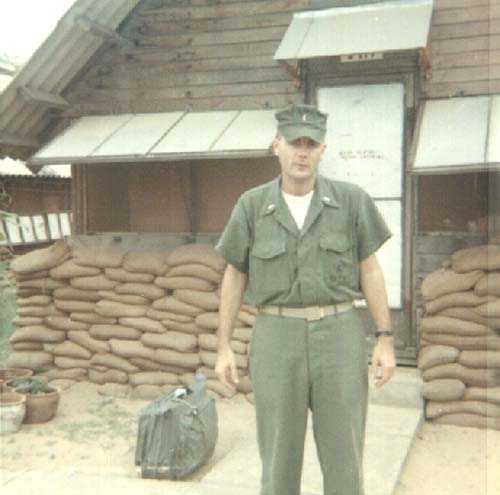 When
the squadron was aboard the USS Princeton as the Special Landing Force,
we went to Subic Bay in the Philippines. I remember flying a mission
that had us supporting the U.S. Embassy in Manila. We landed at the
Embassy pad and shut down waiting for the passengers we were to haul to
Bagio, the mountain summer home of the President Marcos and location of
our Embassy's summer retreat. As soon as the embassy people saw the
dirty beat up UH-34s with "Give a Shit" and the Purple Fox on the tails,
we drew a crowd and all the embassy people were having their photographs
taken next to the "Give a Shit" tail stencils. Nothing like a little
early fame.
When
the squadron was aboard the USS Princeton as the Special Landing Force,
we went to Subic Bay in the Philippines. I remember flying a mission
that had us supporting the U.S. Embassy in Manila. We landed at the
Embassy pad and shut down waiting for the passengers we were to haul to
Bagio, the mountain summer home of the President Marcos and location of
our Embassy's summer retreat. As soon as the embassy people saw the
dirty beat up UH-34s with "Give a Shit" and the Purple Fox on the tails,
we drew a crowd and all the embassy people were having their photographs
taken next to the "Give a Shit" tail stencils. Nothing like a little
early fame.
Stan M. Zenda, Maj. USMC (Ret)
1967 & 1968
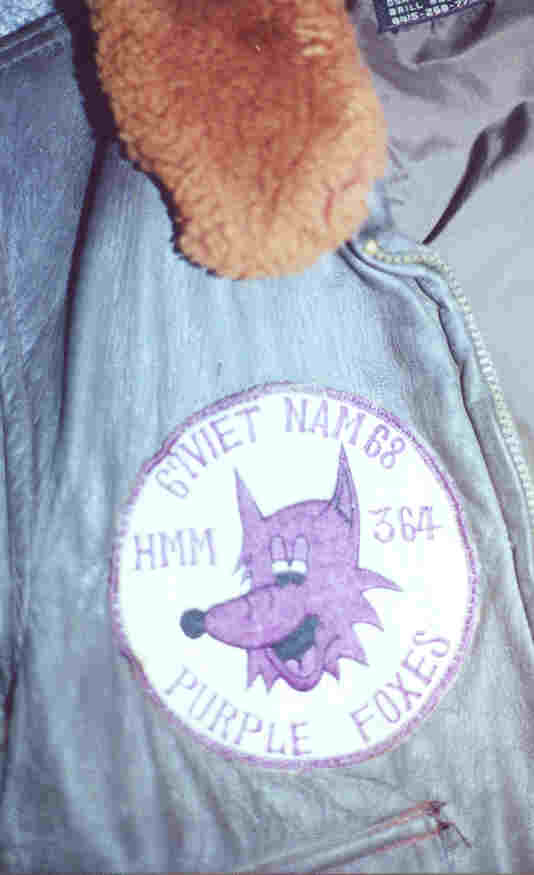

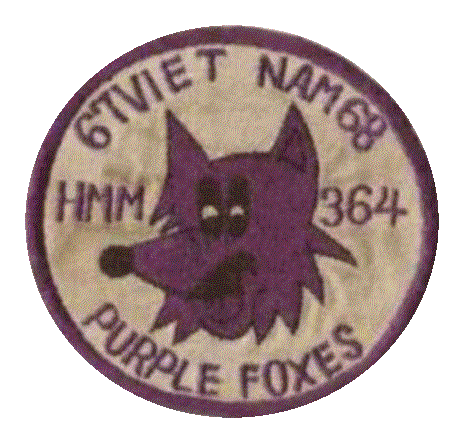
When the squadron was stationed at Phu Bai they developed a patch containing the tour dates.
This picture is Cpl. John Sabol's flight jacket.
John Sabol, Jr., former Cpl. USMC
Late '70 or Early '71
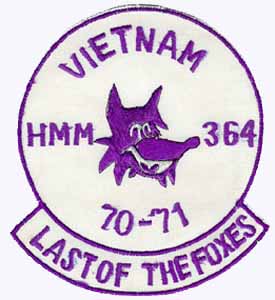
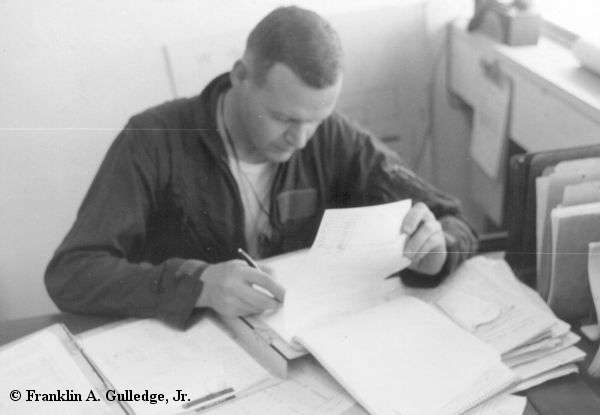 The
arrival of the New Year brought word that HMM-364 would be standing down
and eventually deactivated. As a result the squadron started losing
personnel and aircraft to MAG-16 and other units. This prompted the
Marines of HMM-364 to once again redesign the squadron patch.
The
arrival of the New Year brought word that HMM-364 would be standing down
and eventually deactivated. As a result the squadron started losing
personnel and aircraft to MAG-16 and other units. This prompted the
Marines of HMM-364 to once again redesign the squadron patch.
Franklin A. Gulledge, Jr., Maj. USMC (Ret)
28 September 1984 to 86
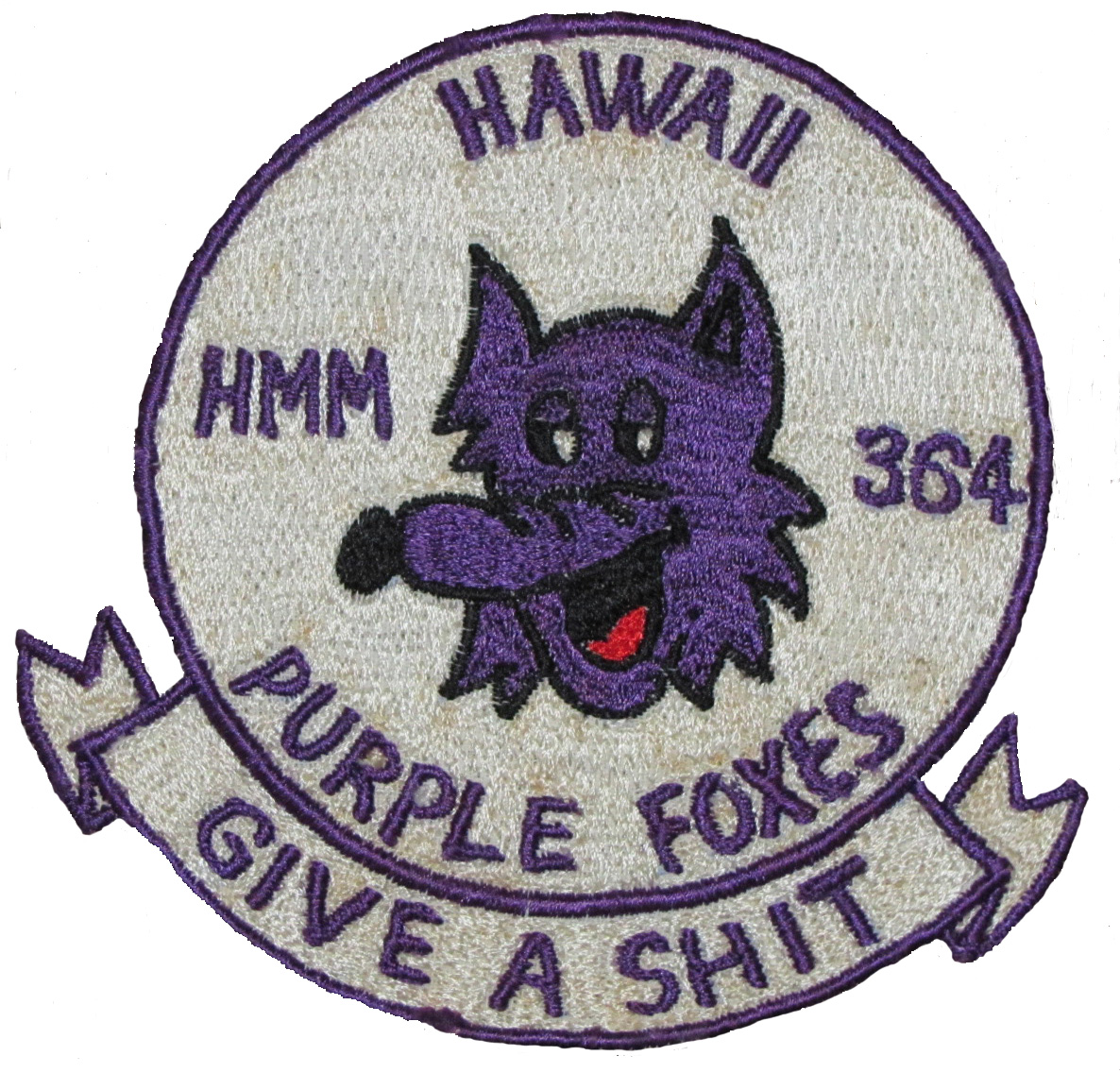
The squadron was reactivated at Marine Corps Air Station,
Kaneohe Bay, Hawaii. The aura and legacy the Purple Foxes had established
during the Vietnam era was remembered and the Purple Fox, known
as Swifty, was also resurrected. Prior to resurrecting the squadron
the Modex numbers of the aircraft were preceded with Yankee Kilo (YK-12),
now the Modex numbers are PF-12 etc. The phonetic alphabet would
make the before mentioned aircraft be called Papa Foxtrot 12 but we all
know that it really means Purple Fox 12. The name of Swifty was probably
due to squadron personnel being advised that the tactical call sign of
the squadron prior to being decommissioned in 1971 was Swift.
During the many deployments to Okanawa and other lacations in the far east Swifty was given a green background during the late 80's. During this era of politically correct conduct swifty was transformed into two patches. One for public use and the other for everyday ware. Can you tell which one the Marines wore most?
 |
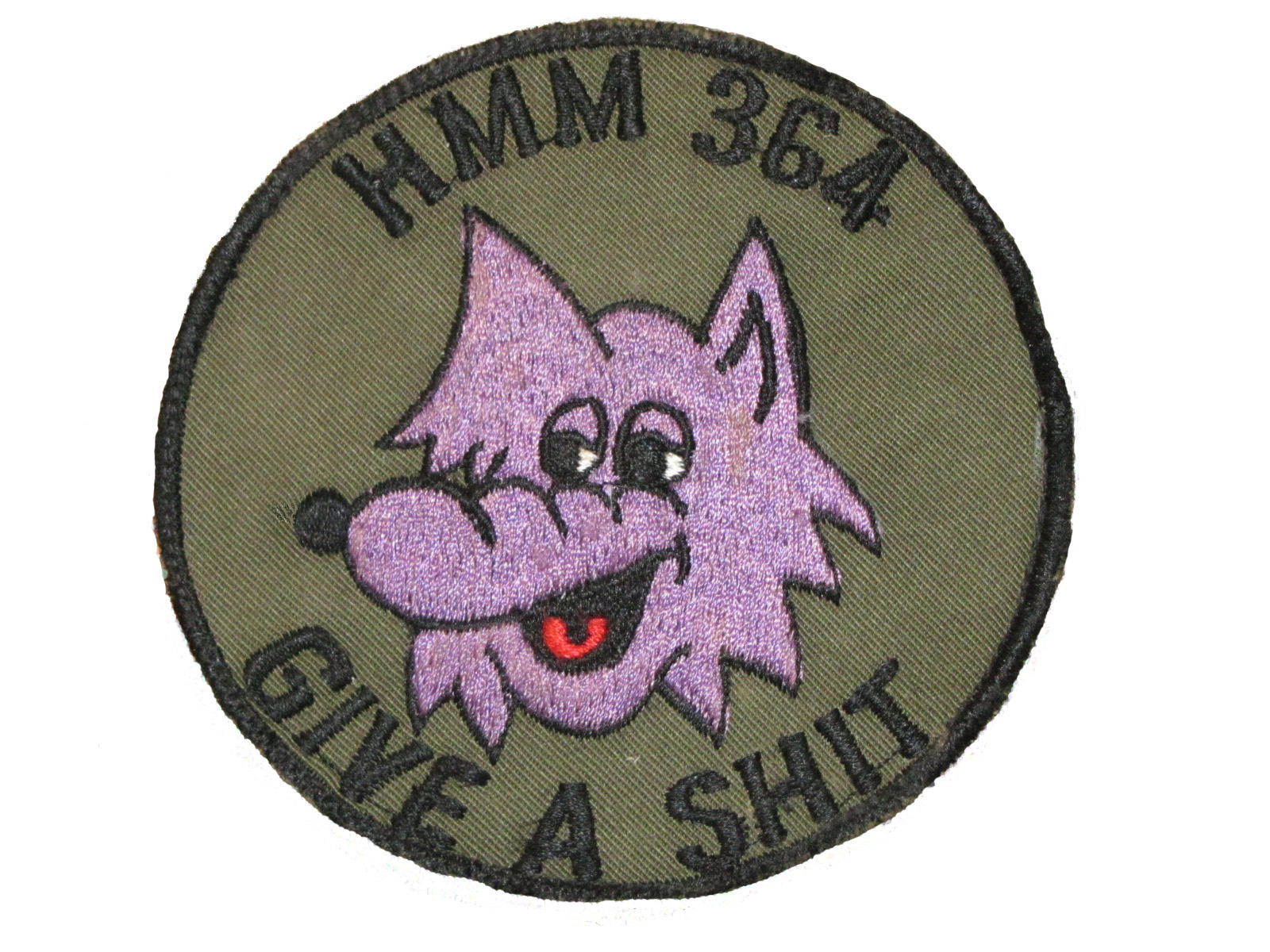 |
The squadron has continued to uphold its legacy with its deployment to Kuwait in January of 2003 and subsequent participation in Operation Iraqi Freedom. On 20 March 2003 the squadron began flying combat missions in support of Operation Iraqi Freedom.
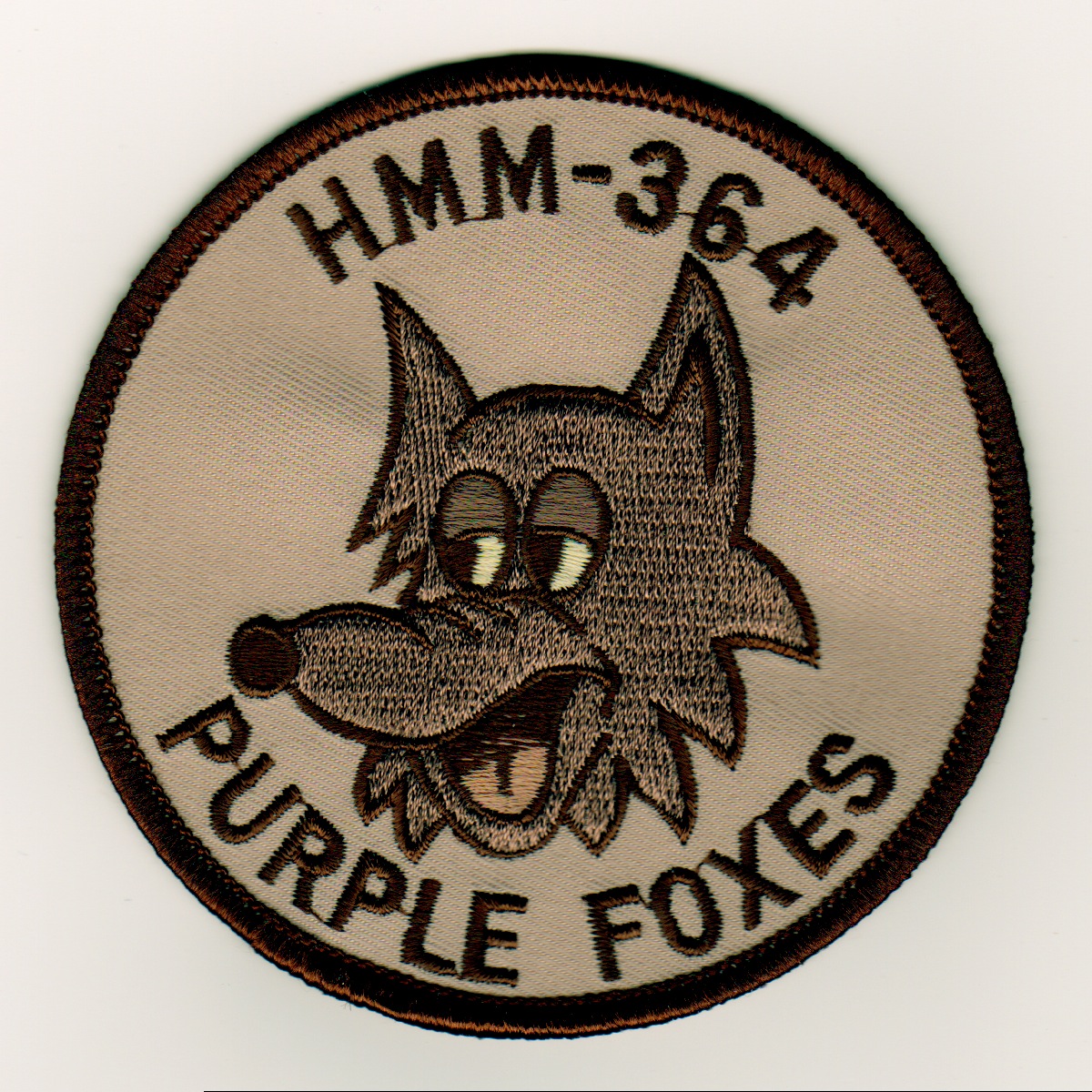 |
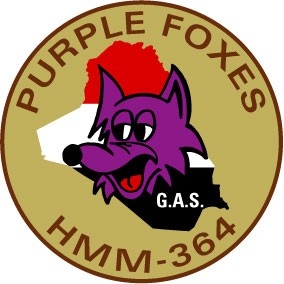 |
|---|
In the winter of 2005, the Foxes again deployed to Al Taqaddum Airfield, Iraq for the primary mission of performing CASEVAC within the Second Marine Expeditionary Force (II MEF) Area of Operations (AO) in support of OIF 04-06. During the seven-month deployment the Foxes conducted 266 CASEVAC missions transporting 603 Urgent, 546 Priority, and 2623 Routine CASEVACs.
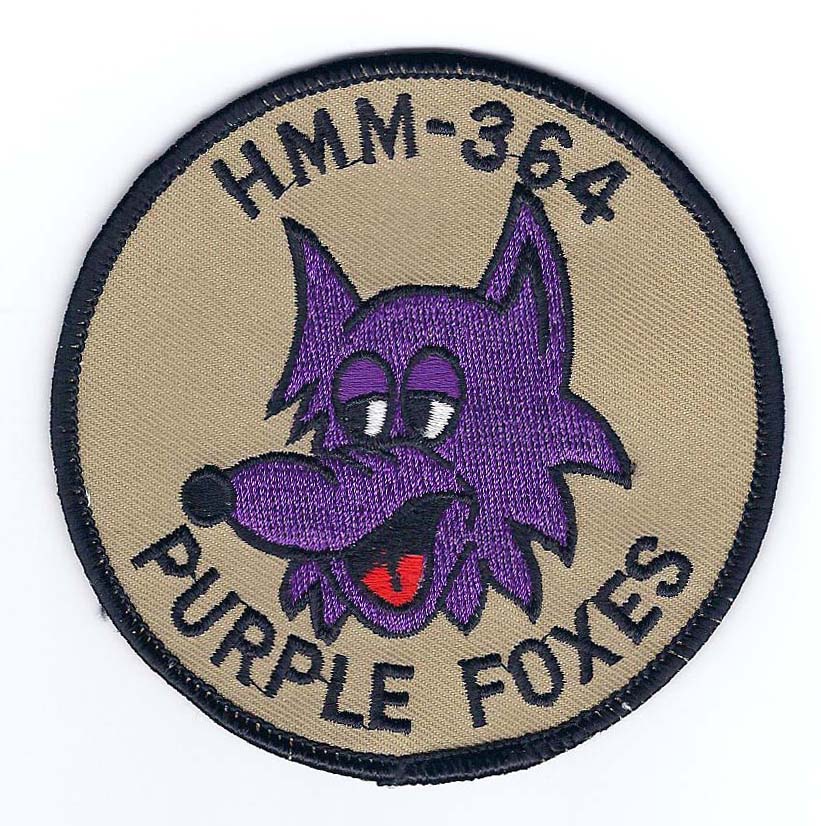 |
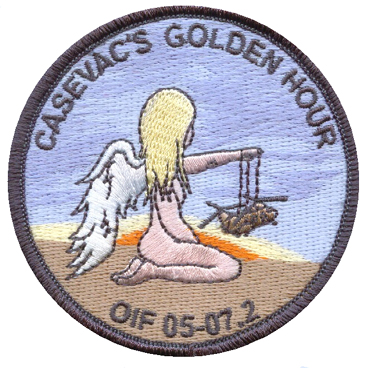 |
|---|
On 19 August 2006, HMM-364 main body departed Camp Pendleton in support of OIF 05-07.2. Throughout the deployment, the squadron supported Marines, soldiers, sailors, and our coalition partners with the “number one cannot fail” mission of OIF by maintaining a 30-minute alert status for CASEVAC, in addition to supporting other general support missions and VIP movements. By the end of the deployment, the squadron flew 6,373 hours lifting 25,516 passengers and 986,332 pounds of cargo. Included in these numbers were 715 Urgent, 187 Priority and 1317 Routine medical patients. The Foxes returned to Camp Pendleton on 13 March 2007.
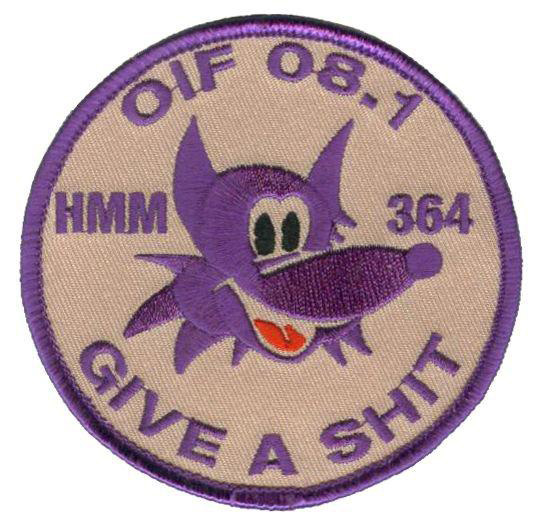
The squadron’s main body departed Camp Pendleton on 10 March 2008 and arrived at Al Taqaddum, Iraq shortly after in support of OIF 08.1. We are still working and there will be more to follow.